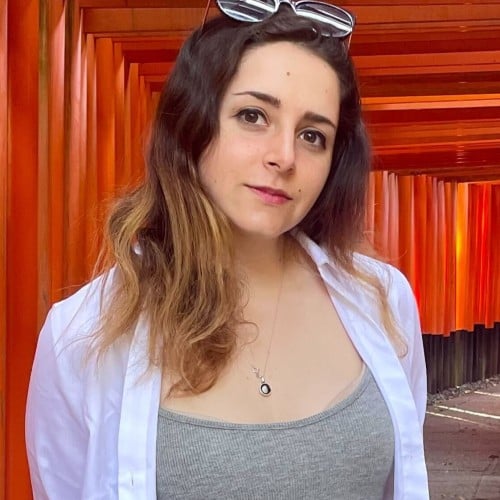
Palaeontologist who worked on ‘Jurassic World Dominion’ explains his role in showing feathered dinosaurs to the world
- Steve Brusatte, author of the bestselling ‘The Rise and Fall of the Dinosaurs’, explains how he fell in love with fossils ahead of his talks at the Hong Kong International Literary Festival
- Every week, Talking Points gives you a worksheet to practise your reading comprehension with exercises about the story we’ve written
 Fossils uncovered in China revealed that many dinosaurs had feathers, but media like “Jurassic Park” hasn’t shown this feature until recently. Photo: AFP / Ministry of Land and Resources of China / Chuang Zhao
Fossils uncovered in China revealed that many dinosaurs had feathers, but media like “Jurassic Park” hasn’t shown this feature until recently. Photo: AFP / Ministry of Land and Resources of China / Chuang Zhao Imagine hunting down a gigantic, ferocious dinosaur with a long snout, nicknamed “Pinocchio rex”. This was one of the most incredible discoveries American palaeontologist Steve Brusatte ever made.
In 2014, he worked with the late Lu Junchang – whom Brusatte described as “one of China’s great dinosaur hunters” – to unearth the 66-million-year-old fossil of an animal that was closely related to the Tyrannosaurus rex.
The professor of palaeontology and evolution at the University of Edinburgh has been to China many times, calling it an “epicentre” of paleontological discoveries.
Brusatte, 39, explained that 30 years ago, a farmer in northeastern China stumbled upon a dinosaur skeleton that shocked scientists because it was “surrounded with a coat of fluffy stuff that looked like cotton”.
Inside the brain of T. rex: the most fearsome of dinosaurs was smarter than you might think
“The discovery of feathered dinosaurs in China in the 1990s totally changed our perception of [them],” explained Brusatte, who in 2018 wrote the New York Times bestselling book The Rise and Fall of the Dinosaurs to educate the public about these incredible ancient creatures.
“Before these fossils were found, dinosaurs were depicted in art and movies as boring, green or grey, overgrown reptiles. Today, we know that many had feathers and looked and acted much more like birds.”
He added: “These fossils proved once and for all that today’s birds evolved from dinosaurs.”
The discovery of a feathered dinosaur sparked a “dinosaur rush”, and palaeontologists flocked to China.
“Now, [we know of] thousands of dinosaurs covered in feathers, some of which even had true wings like birds today,” Brusatte said.
Humble beginnings
Before Brusatte began traversing the globe for fossils, he was a kid in a rural town in Illinois, in the United States, learning about dinosaurs from his brother, Chris.
“[Chris] turned his bedroom into a dinosaur museum,” Brusatte recalled. “He had all the Jurassic Park toys, and we watched Jurassic Park all the time. Over time, his interest became [mine].”
In 2013, he completed his PhD in Earth and environmental sciences at Columbia University in the US. Brusatte and his family now live in Scotland, and even though his job largely consists of teaching and research, the day-to-day life of a palaeontologist can vary.
“If you caught me a few days ago, I would have been teaching. If you [catch] me in a few months’ time, I might be out in the desert, [digging up] dinosaur bones,” he pointed out.
Educating the public
In the two decades since the start of his career as a palaeontologist, Brusatte has made incredible discoveries and plays an important part in educating the public about dinosaurs.
Along with being featured in several documentaries, Brusatte had a hand in one of the Jurassic Park films.
In 2020, he was part of a consulting team of palaeontologists on Jurassic World Dominion. He had been in touch with the production team and reportedly made the director promise to include feathered dinosaurs for the first time in a Jurassic Park film.
“It has been one of the joys of my career working on the films,” Brusatte said. “I know these are blockbuster monster movies, not science documentaries. Moviemakers will not always make perfectly scientifically accurate dinosaurs, and that is OK.”
Brusatte has written books about dinosaurs and mammals and is currently writing about birds.
“When I’m writing these books, I’m thinking about me as a 15-year-old [or] 16-year-old in high school,” he said, “I tried to tell stories about science, fossils, and the people studying [them] without getting too technical.”
Brusatte will discuss his books at the six-day Hong Kong International Literary Festival. He will participate in two talks: the first is an educational workshop catered towards youngsters aged three to 10, which will use his wife’s children’s book, Dugie the Dinosaur, to introduce kids to fossil discoveries.
Meanwhile, the second talk, better suited for adults, will dive into his 2018 book.
The palaeontologist hopes people can see how fossils are relevant to problems we face today, especially regarding climate change.
“Fossils are lessons from the past that can inform our future. Dinosaurs and other fossils are real animals that dealt with real moments of climate and environmental change, and we can learn a lot from them,” he said.
To test your understanding of this story, download our printable worksheet or answer the questions in the quiz below.
